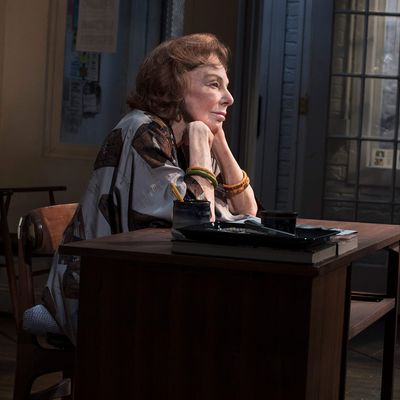
There’s both a lot and very little happening in Kenneth Lonergan’s The Waverly Gallery. The “lot” is contextual: The 86-year-old comedy dynamo Elaine May is returning to Broadway for the first time since 1960, when she performed in this same theater as part of an era-defining sketch duo with Mike Nichols. Lonergan’s play, its director Lila Neugebauer, and Lucas Hedges, who plays its narrator (and was nominated for an Oscar for his performance in Lonergan’s film Manchester by the Sea), are all making their Broadway debuts. Michael Cera and Joan Allen are rounding out the cast, along with David Cromer, whose own directing work — from The Treasurer to Our Town to The Band’s Visit — sits in conversation with The Waverly Gallery, a play that’s dedicated to the meticulous commemoration of the unextraordinary.
That’s the “very little”: The Waverly Gallery isn’t so much a drama as it is an observance, in both senses of the word. With an ear like a tape recorder, Lonergan follows the descent of a woman into dementia. We watch her mind and personhood fracture as her family struggles to figure out — day by day, loss by loss — what to do with her. In the memory-play tradition, her grandson crosses the fourth wall to speak to us, turning her deterioration into a kind of rite. “[This] really happened to her,” he says, “and it seems like somebody should remember it.”
For a while, the experience of watching The Waverly Gallery can feel like cognitive dissonance. As the play’s starry container rubs up against its intentionally unassuming contents, the little, which is what Lonergan is interested in, gets temporarily subsumed in Broadway bigness. When I saw the show, the audience showered May with applause as soon as the gray brick wall concealing David Zinn’s hyperreal set flew out to reveal her — as Gladys Green, owner of the titular gallery — seated at a desk inside it, chatting with her grandson Daniel (Hedges). Gladys is garrulous and charming, her conversation that familiar blend of repetition, reminiscence, benign judgment, and kind, if forgetful, personal inquiry that we’ve all engaged in with someone who’s closer to 100 than 50. And May is excellent — understated and lively, both sharp and loose, balancing the inherent humor of Gladys’s slips in memory with a sense of the embarrassment and deep loneliness the character is working so hard to hide. What’s strange, at least for a time, is the raucous laugh track. The audience around me came ready for comedy, and May’s every quip brought guffaws and sometimes even ovations. While Lonergan’s play is funny, it’s quiet-funny, painful-funny, knowing-half-smile-funny; only gradually, in a few calculated moments of release, is it big-funny, and even then its humor is never built for the laugh.
I don’t mean to criticize my fellow audience members — in my hometown, a local critic once implied that I must have been an audience plant at a play that I happened to find hilarious. I simply found myself somewhere else, more detached from the carefully calibrated conversations I was watching than wrapped up in them. Perhaps it’s the inevitability: The Waverly Gallery’s trajectory is clear from its opening moments. Gladys’s mind will fall apart, is already falling apart, and we will watch it happen. And if we ever find ourselves questioning the lack of drama, the essential mundanity of the circumstances, we’ll immediately wag a mental finger at ourselves because that’s what we’re here to glorify. “Somebody should remember,” says Dan, and we lower our heads in respect, wanting to be those somebodies, making Gladys’s story — which happens to so many families — into a kind of symbol, a monument at which to pay our respects for the unacknowledged ache of hundreds of thousands. Perhaps we’ll be kinder in our minds to Gladys, more cognizant of the depth of her suffering, than we’ve been to our own families. Almost certainly we will.
There’s nothing wicked about that. That’s part of what stories do — give us a chance to clarify and focus our empathy, distilling our best human instincts for listening and compassion from the compromised messes of our own lives, where it can often be hard to find their essence in the muddied stream. My trouble with The Waverly Gallery, despite its painstakingly relatable dialogue and situational poignancy, is that I couldn’t shake the feeling that I wanted it to do something else too. Watching Cromer as Gladys’s son-in-law Howard — a pragmatic, well-meaning man with a wry sense of humor and a tendency to try to shout his way through her hearing aid — I thought back to his production of The Treasurer, another story of an aging woman whose mind is crumbling and whose family, especially her son, are coping with the scattered pieces. As directors, both Neugebauer and Cromer are interested in the ways the expansive lives inside the everyday, in Thornton Wilder’s assertion that “there’s something way down deep that’s eternal about every human being” and even “the least important day in your life” is “important enough.” But Cromer, with both The Treasurer and Wilder’s Our Town, has gotten to work with material that finds the rich theatricality of these ideas, that turn the stage into a conjuring place of shifting, overlapping realities, where the the lines between mind and matter, even between life and whatever comes after, are thrillingly, devastatingly blurred.
With Lonergan’s play, Neugebauer gets nothing so layered, so interested in the unique potential of theater to unlock more than the factual step-by-step of Gladys’s story. She still does mightily impressive work with her actors: They calmly weather the tempest of laughter at the play’s beginning with her cool guidance, staying steady, focused, present, never overplaying a note. Hedges is at times almost a blank slate as Dan, the kind of smart, diffident young man whose experience of the world is still quite small, whose humor runs toward irony, and who will take a long, long time to find his emotional center, if he ever does. Cromer paints an effective picture of pretty much exactly that kind of man, grown up — though he’s Dan’s stepfather, the pair share a proclivity for dry detachment. “We’re liberal Upper West Side atheistic Jewish intellectuals,” says Dan, and the home crowd goes wild. Michael Cera does a downplayed version of his patented awkward thing, plus a Boston accent, which works well for Don, the hardworking if clueless artist who befriends Gladys and exhibits in her gallery (and crashes in the back room). Don is the kind of person who listens to everything you’re saying, pauses, then blithely goes on talking about himself, not out of malice or even vanity but simply because he can’t quite comprehend anyone else’s reality. When his car gets vandalized, Cera’s flustered, I-don’t-want-to-blow-up frustration is genuinely funny: “I gotta admit I’m very, very discouraged by this city,” he squeaks, and you just wanna hug-slap him. Oh, sweetheart.
It’s Joan Allen, though, who’s up there with May, giving the show its heartbeat. As Gladys’s daughter Ellen — an immensely capable, intelligent doctor whose impatience with her dwindling mother is mingled with, and concealing, fear and heartbreak she can’t fully register — Allen is sneak-up-on-you stunning. Even when her Ellen says things like “I wish she would just die peacefully in her sleep” or “When I get senile, just put a bullet through my head,” or when she finally explodes at Gladys — who keeps attempting to feed the family dog against Ellen’s express orders — we never feel cruelty in her performance, only the terrible, terribly common reality of trying to be a good daughter, of caring for a parent without really fully loving them, of being an efficient, hypercompetent person with no ability to fix something that’s breaking.
Neugebauer and May precisely locate each beat of Gladys’s disappearance as the person she once was. May is predictably spot-on with the play’s humor, and both piteous and powerful in the story’s latter stages, where Gladys slips and panics and rambles, desperately reaching out of the lonely fog that envelops her. When Howard, cheerful and banal, shouts, “IT’S NO FUN GETTING OLD,” she stops short like a cat drawing back from being pet, eyeing its caretaker like the condescending know-nothing he is: “Well why do you always say that to me?” she demands. “Nobody wants to hear that!” Gladys was a huge personality in her younger days, the kind of witty, worldly, connected New York woman that you went to “if you wanted anything done.” Now she’s ringing her grandson’s doorbell three times a night (they live in the same Greenwich Village building), unable to remember what he does for a living or where she put her keys or sometimes even who he is, uncertain of what’s happening to her and ashamed and afraid of it.
“This whole neighborhood is changing,” Gladys keeps saying — and we watch projections (by Tal Yarden) of the transforming face of the Village on that big gray wall that descends in front of the set during each scene change. The world is slipping away from Gladys even as she’s slipping away from it, and it’s a gasping, drawn-out parting, a kind of mental drowning. As multiple fully furnished sets appeared, and as Gladys and her family moved crack by crack toward the inescapable final disintegration, I could feel the theater settle, now understandably reverent in the face of this quiet, quotidian tragedy — but I could also still feel my own detachment. Lonergan’s text seems to call for high realism, and that’s what Neugebauer and her designers give it, which means that there’s no other register in The Waverly Gallery beyond the keen observance of detail. The play tells us that we should remember Gladys’s story, but doesn’t take advantage of the infinite potential of its form in the telling of it. There are lots of things we should remember, from flossing to giving to charities, but what makes us remember theater is revelation. By confining itself to a familiar box, even an expertly rendered one, The Waverly Gallery ends up feeling smaller than it should, especially when its very mission is to see the world in a grain of sand. Even in the sensitive hands of its actors, especially May and Allen, it’s an affecting play, but not a revelatory one.
The Waverly Gallery is at the John Golden Theatre.


